Weather and Climate - PowerPoint PPT Presentation
Title: Weather and Climate
1
Weather and Climate
CHAPTER 3
- Section 1 Factors Affecting Climate
- Section 2 Weather Factors
- Section 3 Climate and Vegetation Patterns
2
Objectives
Section 1Factors Affecting Climate
- How does the Sun affect Earths atmosphere?
- How does atmospheric pressure distribute energy
around the globe? - How do global wind belts affect weather and
climate? - How do the oceans affect weather and climate?
3
Effect of the Sun on Earths atmosphere
Section 1Factors Affecting Climate
- Some solar energy, in the form of heat, reflects
off Earth back into the atmosphere. - Atmosphere traps this heat energy in a process
called the greenhouse effect. - Process helps keep the planet warm.
4
Atmospheric pressure and energy distribution
Section 1Factors Affecting Climate
- Low-pressure zones are caused by warm air, which
expands and rises. - High-pressure zones are caused by cold air, which
is dense and sinks. - Pressure differences cause air flow and energy
distribution around the globe. - Warm air moves through the upper atmosphere until
it cools and falls cold air moves along Earths
surface until it heats up and rises.
5
Global winds affect weather and climate
Section 1Factors Affecting Climate
- Pressure differences cause wind.
- Winds move heat and cold across the Earths
surface. - Prevailing winds blow from the same direction
most of the time, causing similar weather. - A front occurs when two air masses of widely
different temperatures or moisture levels meet.
6
Oceans affect weather and climate
Section 1Factors Affecting Climate
- Water heats and cools more slowly than land,
making coastal areas milder than inland areas. - Ocean currents move heat between the tropics and
polar regions, helping to maintain Earths energy
balance.
7
Objectives
Section 2Weather Factors
- What are the common forms of precipitation, and
how are they formed? - How do mountains and elevation affect weather and
climate? - What are the different types of storms, and how
do they form?
8
Forms of precipitation
Section 2Weather Factors
- rainliquid formed through condensation of water
vapor - snowice crystals formed in clouds
- sleetrain that freezes as it falls
- hailchunks of ice formed in storm clouds
9
Effects of mountains and elevation on weather and
climate
Section 2Weather Factors
- Increase in elevation causes drop in temperature.
- Mountains cause orographic effect moist air
meets a barrier and is pushed upward, causing
cooling, condensation, and precipitation. - Mountainside facing wind is the windward, wetter
side side facing away from wind is the leeward,
drier side, called the rain shadow.
10
Types of storms
Section 2Weather Factors
- Middle-latitude storms form when cold dry polar
air mixes with moist warm tropical air. Examples
include thunderstorms and tornadoes. - Tropical storms are usually smaller and lack
fronts. Examples include hurricanes and typhoons.
11
Objectives
Section 3Climate andVegetation Patterns
- How do the two tropical climates differ?
- What conditions are common in dry climates?
- What climates are found in the middle latitudes?
- What characterizes high-latitude and highland
climates?
12
Differences in the two tropical climates
Section 3Climate andVegetation Patterns
- Tropical humid climate
- close to equator
- generally warm and wet year-round
- climate supports dense rain forests
- Tropical wet and dry climate
- farther from equator north and south of the
tropical humid zone - warm wet season alternates with cooler, drier
season - seasonal variation supports savannas tropical
grasslands with scattered trees and shrubs
13
Dry climate areas
Section 3Climate andVegetation Patterns
- generally centered about 30 degrees north and
south of equator - subtropical high-pressure zone causes sinking dry
air, with little rain - winters may be cold, summers very hot
- hardy plants and animals
14
Middle-latitude climates
Section 3Climate andVegetation Patterns
- Mediterraneanlong, dry summers and mild winters
scrub woodland vegetation - humid subtropicalhot, humid summers and mild
winters temperate forests - marine west coastmild year-round may support
dense forests - humid continentalvariable, with four seasons
enough rain to support forests
15
High-latitude and highland climates
Section 3Climate andVegetation Patterns
- subarcticlong cold winters and short warm
summers vast evergreen forests - tundralong winters, with permafrost low
vegetation - ice cappolar climates, with few plants or land
animals - highlandclimate varies by elevation, with low
elevations relatively mild and high elevations
similar to ice cap

